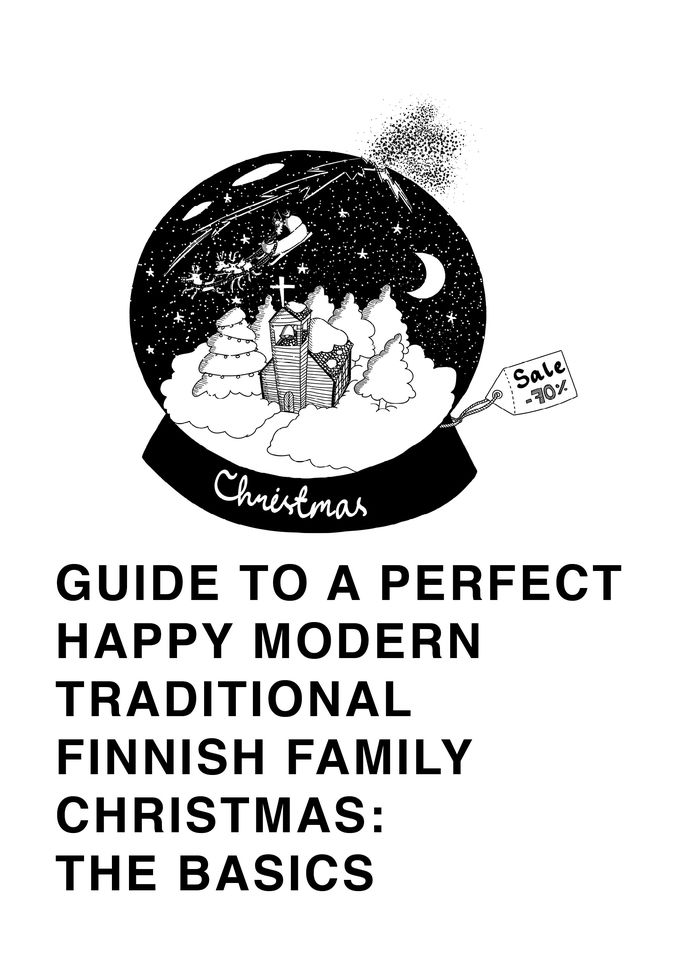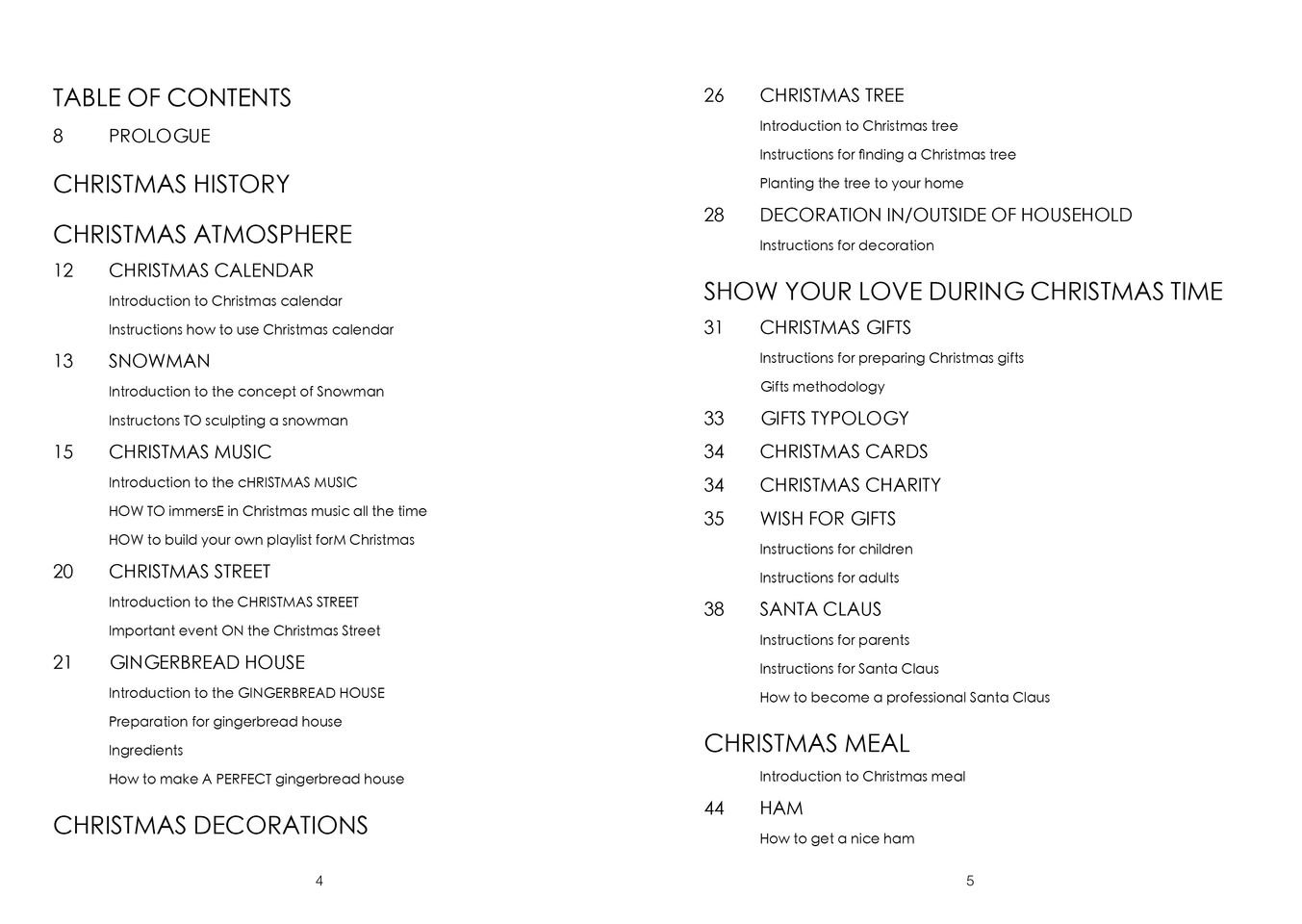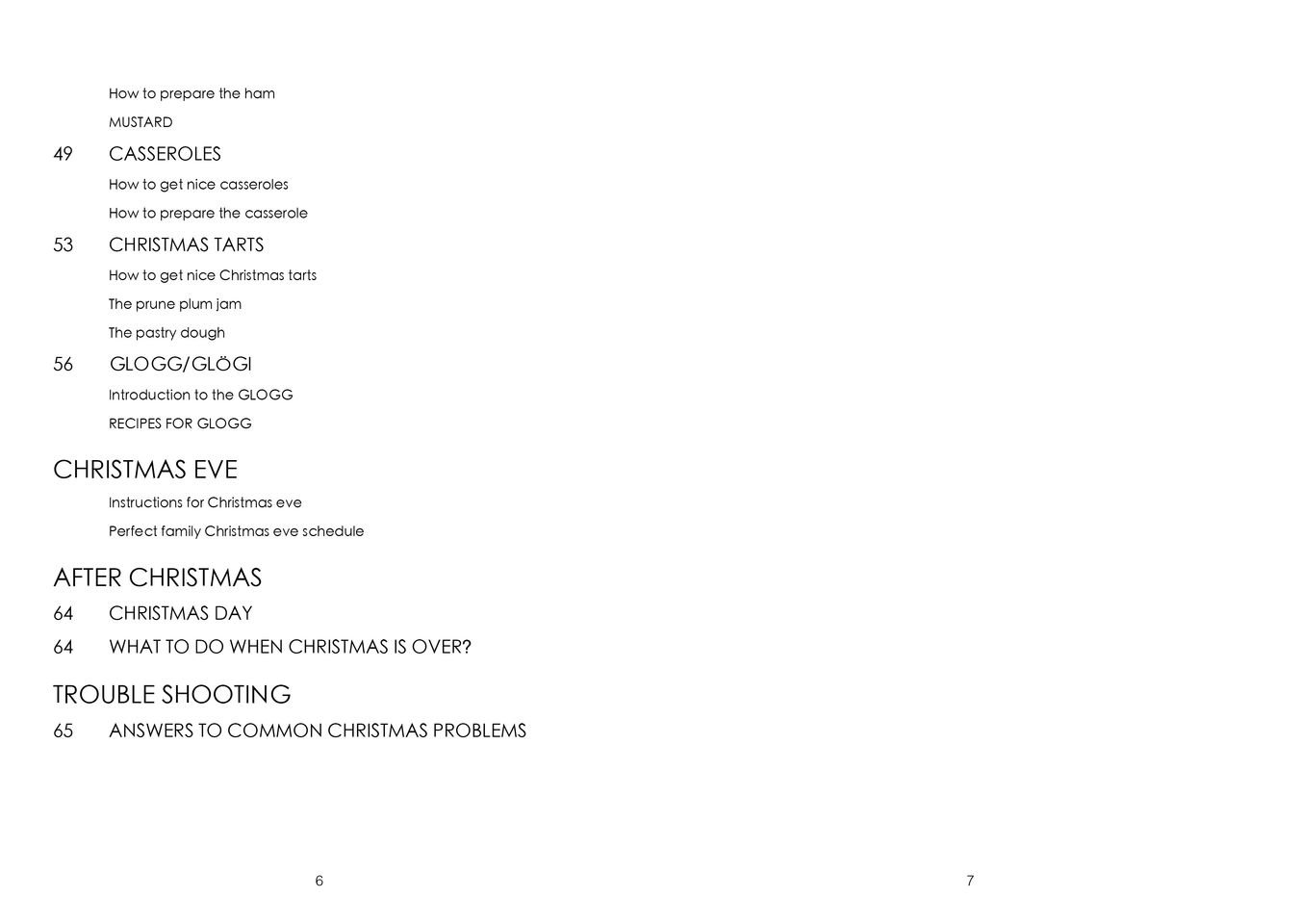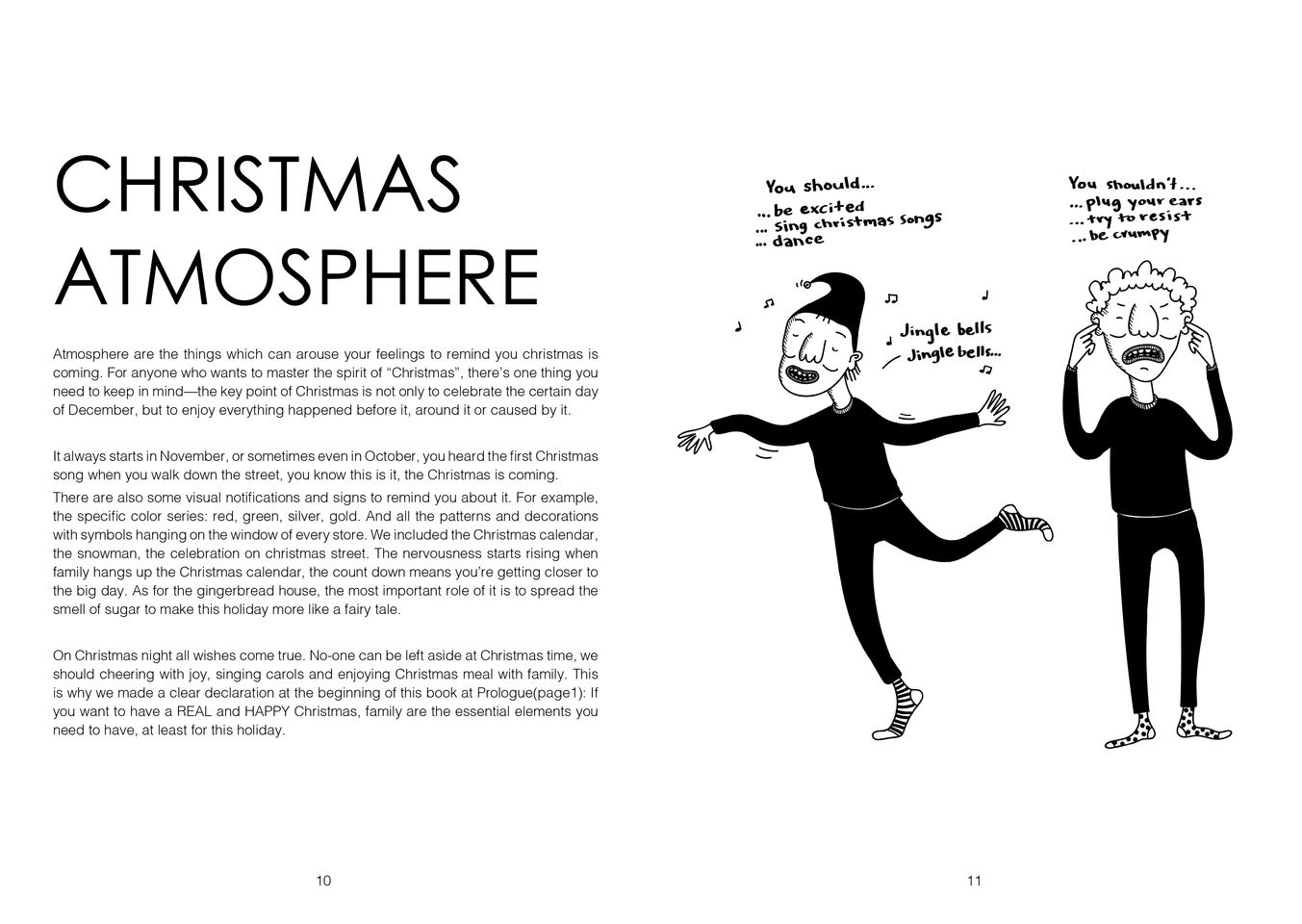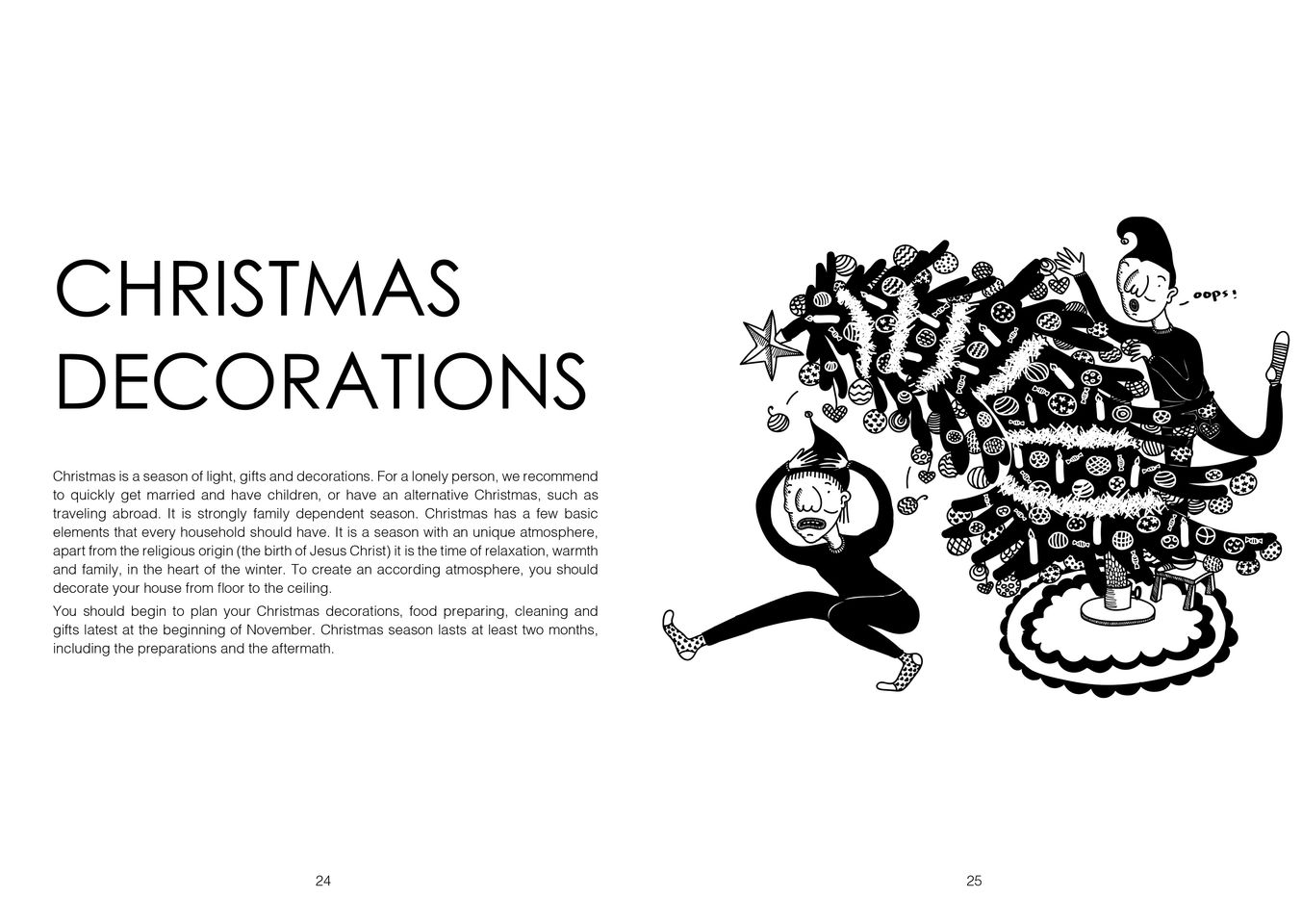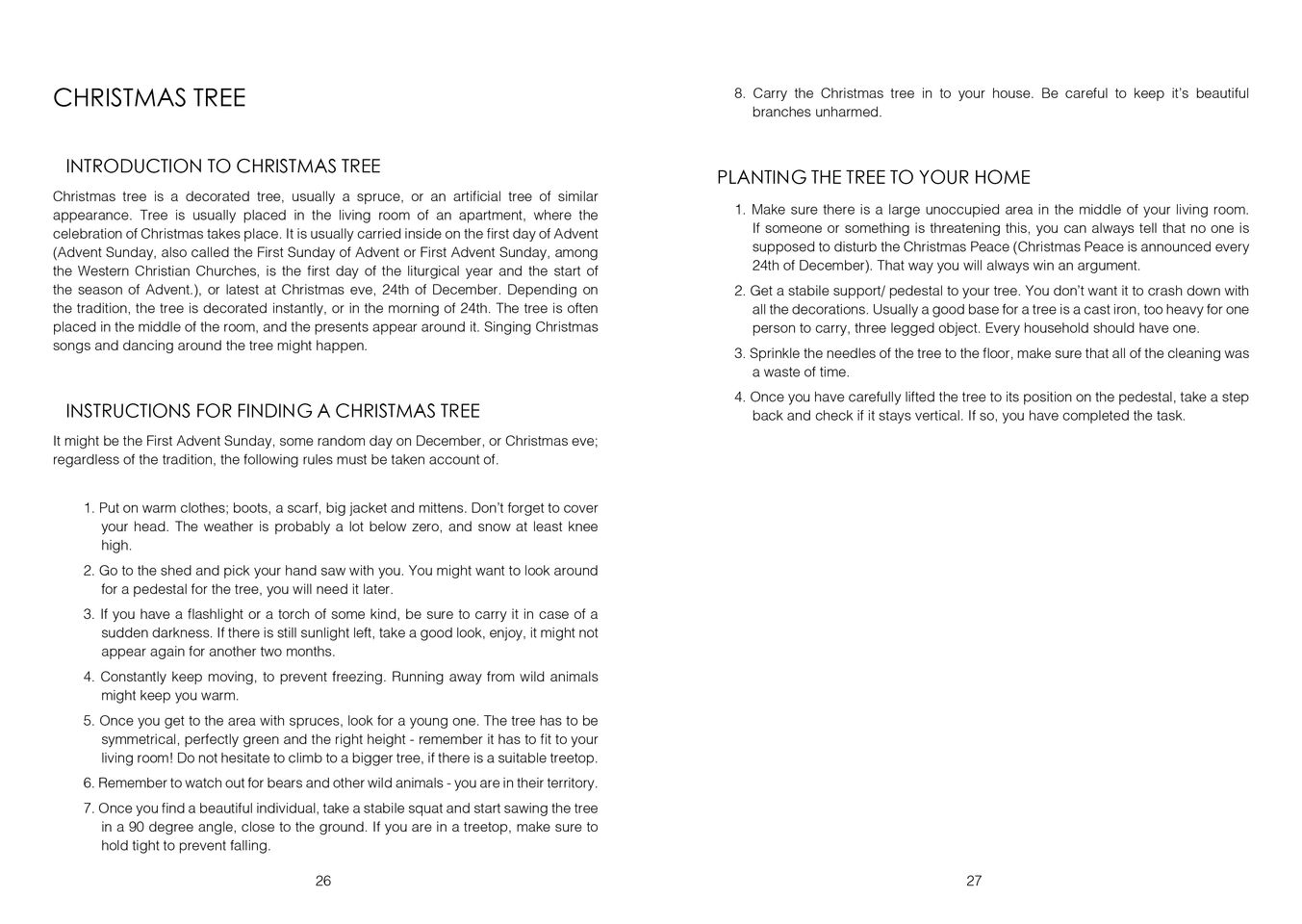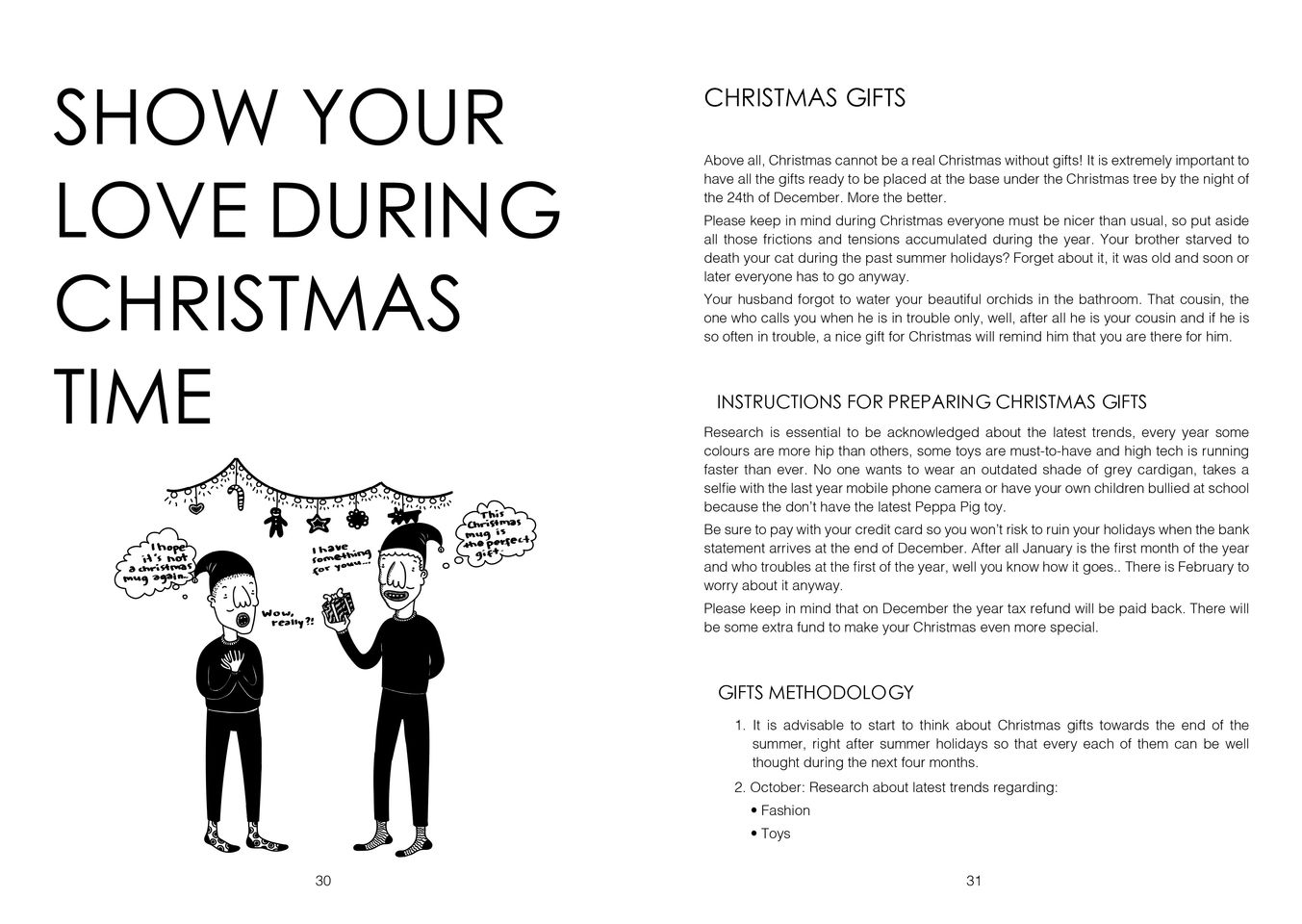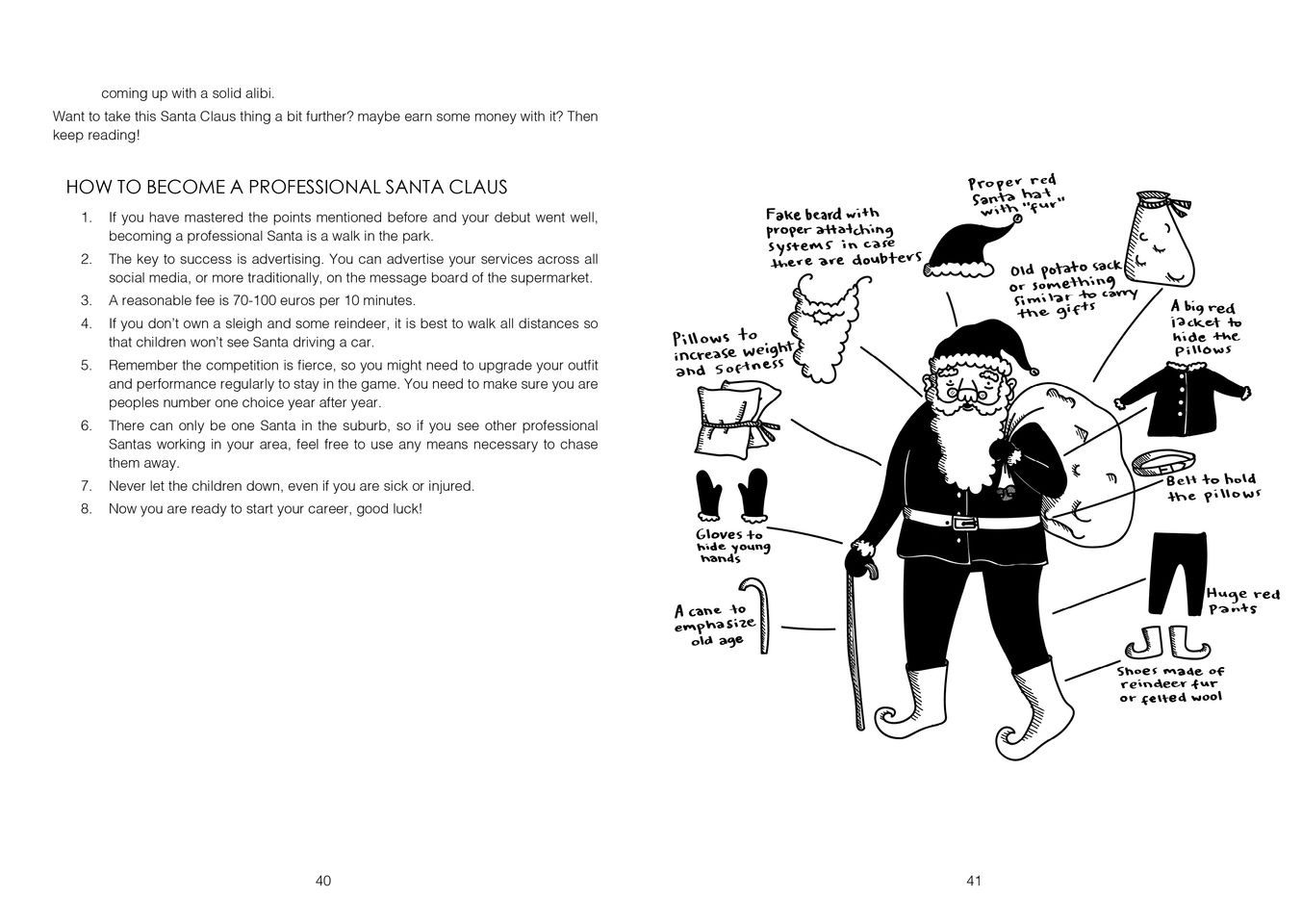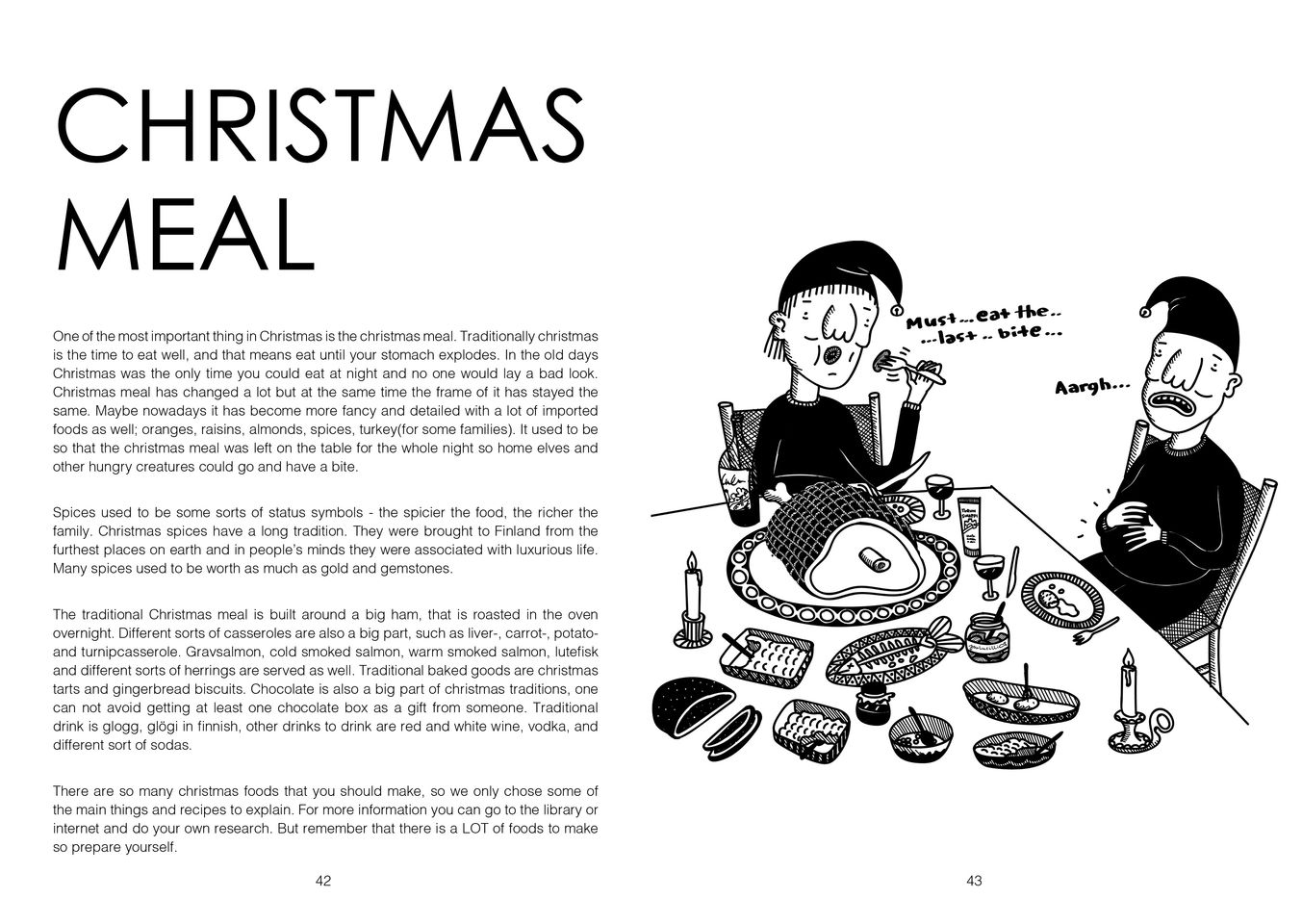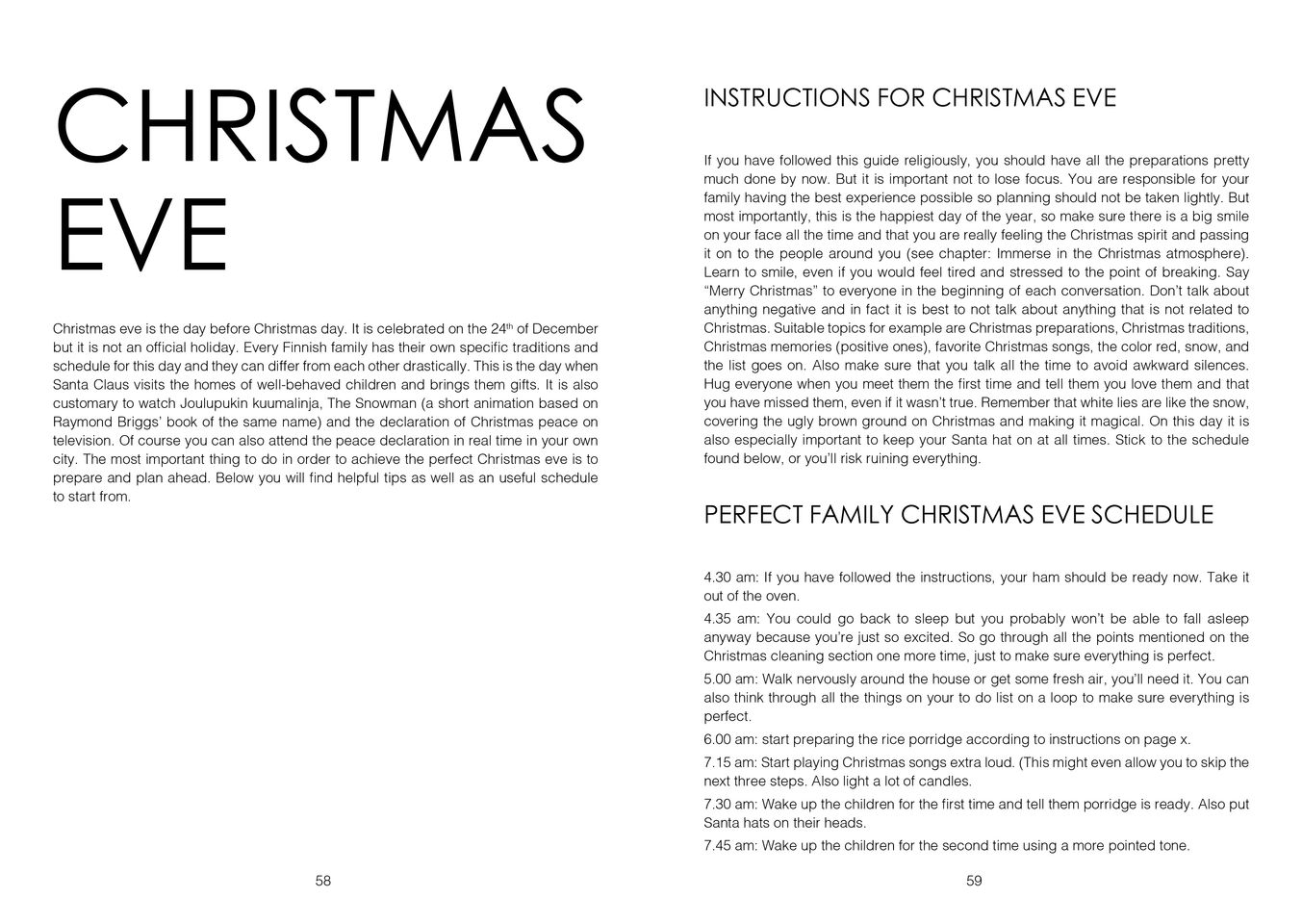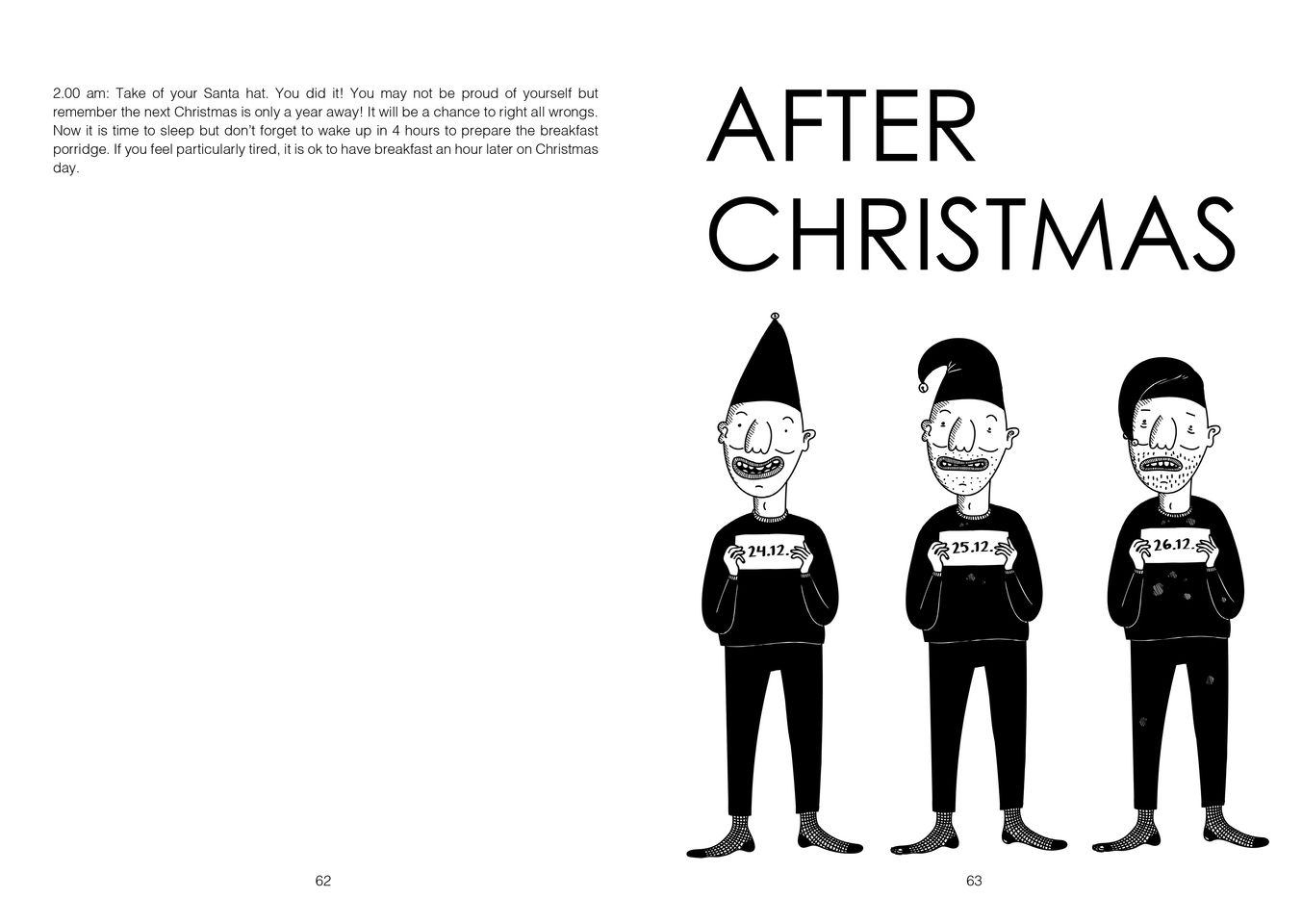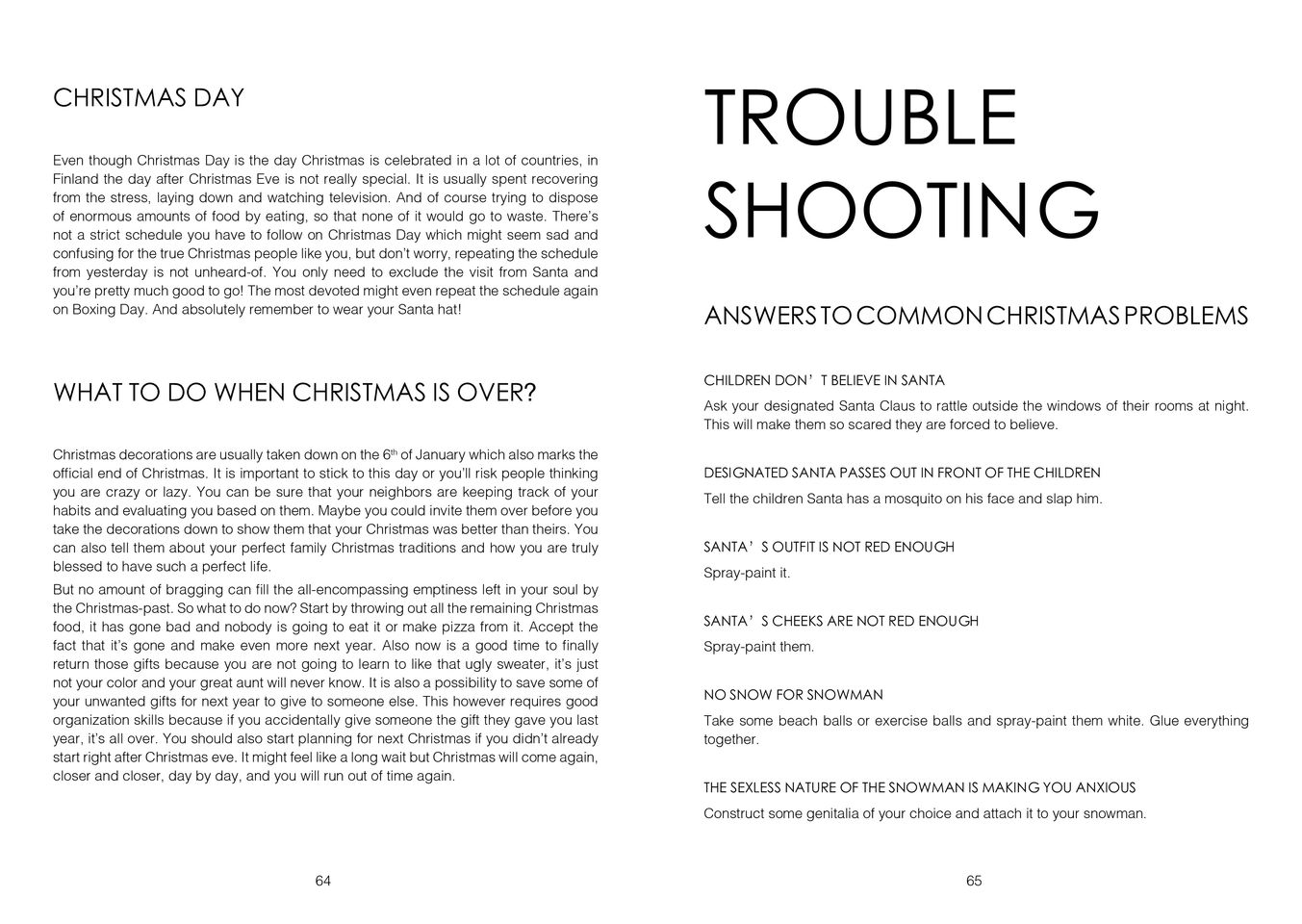GUIDE TO A PERFECT HAPPY MODERN TRADITIONAL FINNISH FAMILY CHRISTMAS: THE BASICS

Abstract
This project is rooted in the overconsumption and people’s psychology behind it, we choose Christmas as an agent to state our declaration, because Christmas as a holiday is a very concrete example of it.
As for the outcome, we develop a guidebook which focused on the traditional Finnish Christmas. It points out the necessities of the holiday, how and when it should be celebrated. The purpose of this project is to concretize the quantity and volume of essential Christmas objects and traditions. By demonstrating how to have a real and happy stereotypical Christmas, we try to raise the awareness of how people regulated by this modern Christmas frame and all the consuming behind it.
Research: From consumerism to Christmas
People's attitudes and consumerism
After dividing into groups and getting to know each other started the conversation around the future problems. Soon we came to the conclusion that people are the main cause of global problems such as environmental, (lack of natural resources and diversity of species) social, (people discriminating each other, ignorance, unawareness, lack of education) political, and the list goes on. This leads us to think that the actual, effective change lies under the attitudes of people. At least here in the Nordic countries, even in the whole Europe people are well educated, in other words, aware of the current situation. People are aware that the problems mentioned above do exist, yet do nothing or very little about it.
Since ”attitudes of people towards global problems” is a rather broad topic we had to narrow it down and focus on some of the subcategories that came up earlier in the discussion. We mentioned laziness, seek for comfort, lack of interest and such attitude problems. These all go under the topic ”consumerism”, which represents the individual’s attitude and action as a part of society. Consumerism was the main category we started to research on, in order to find a specific way to approach the subject. Each of us read an article about the history of consumerism (Trentmann, 2016). The given readings reflected our interests, ”Despite unparalleled and increasing access to resources, knowledge, and technology, we had become so pessimistic and cynical. Our conclusion was that whilst, as voters and consumers, we have become experts at choosing and complaining, we have forgotten how to envisage what we really want. Without new dreams, humanity will become extinct.” (Wood, 2007)
Watching the documentary “Century of the Self” (Curtis, 2005) gave us a good overview of consumerism history and development of society and psychology. The documentary told us, that US government purposely made people less active (societally activist) by making them consume more, to respond their unconscious greed for things, social status, sexual attraction.
How Humans Became 'Consumers': A History, by Frank Trentmann, 2016Consuming is life, consuming is power, consuming is duty.
Useful / Useless
We looked the consumption from designer’s point of view. While we were looking for examples of critical design projects, we realized that we were interested in projects that included some kind of useless products. We then started to question things like why people buy useless products? What kind of product is useless? How to design something that is useful/useless? If the definition of useless differs from individual to individual, is there really useless design? How to design something that is totally useless for everyone?
While on holidays, tourists tend to acquire memorable tangible reminders of their special time, in the form of souvenirs and artifacts which do not only function as reminders of the destination visited, but they may also symbolize tourists' traveling experience, and at the same time represent a particular gaze (Morgan and Pritchard, 2005, Watson and Kopachevsky, 1994)
In other words, souvenirs tend to be objects that symbolize the memory for of the place or event. Therefore its main function is to be visible; not in use of any kind. Of course there are souvenirs and other objects linked to special places that do function in various ways, for example a knife from a souvenir shop could very well be adapted to everyday use while still representing its origin and the memory of the trip.
We researched ’useless’ designs, and as a great example we found Japanese Chindogu (meaning unorthodox). The term was invented by Japanese Kenji Kawakami, and it describes the invented art objects that are ’chindogu’. Objects tend to appear funny, even crazy but are still useful in a way.
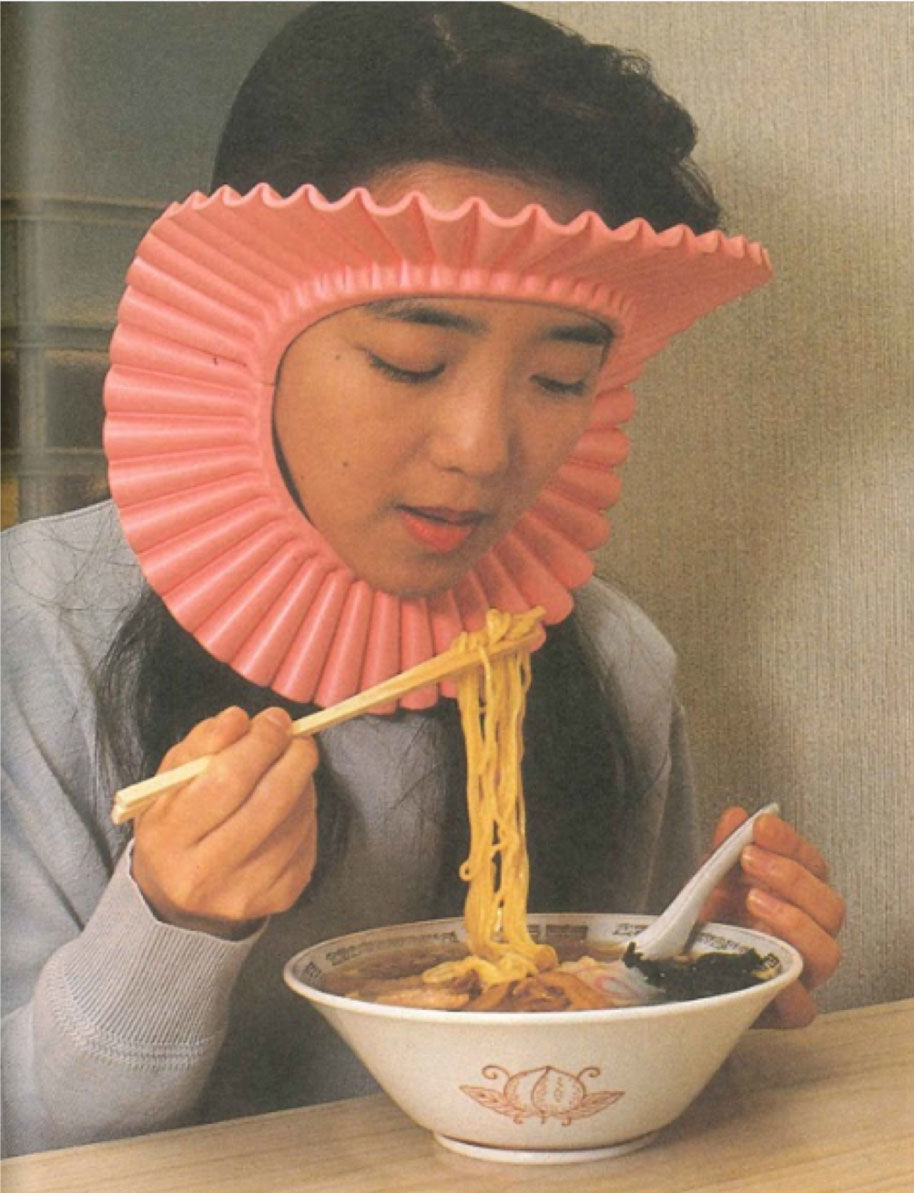
Chindogu.com
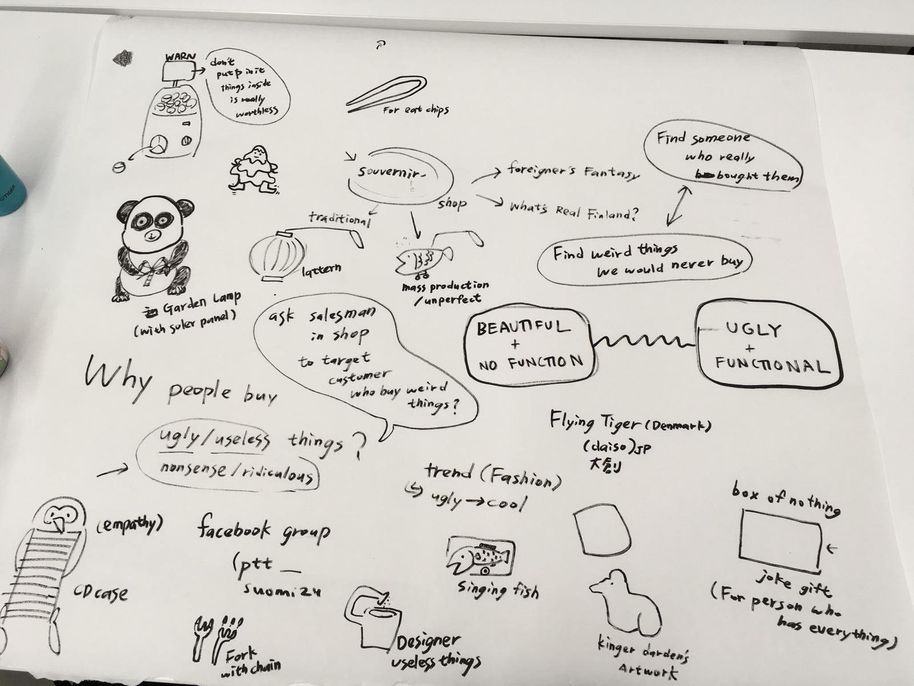
Towards Christmas
Christmas is the time people consume the most and many of the related objects have no function during other times of the year. After pondering around consumerism, souvenirs, useless designs, Christmas seemed to be a logical culminating event, since it more or less encapsulates all of our research into one day. Christmas has become so commercial, therefore so much about consumption that we could not think of something more suitable example.

beliefnet (http://www.beliefnet.com/news/the-7-worst-black-friday-disasters.aspx?p=6)
We wanted to create a guide to a stereotypical Finnish family. Traditionally families have one/two parents and kid/kids. All sorts of relatives are included. We figured, that by writing an overload of instructions and explanations of the details of Christmas, we would get the message delivered. The message being, the era of overconsumption should be over. We do not address an alternative, but criticize the existing culture. This guide book is intended to raise awareness of the amount of consumption demanded each Christmas. It is written with a sarcastic tone, as a device to get the message through.
We started by writing down key points and details about the season. What kind of features does Christmas have? Which of these to include to the book? We divided the points to categories, which eventually ended up being the main categories in our book. Atmosphere, Decorations, Showing Love (gifts), Food, Christmas Eve, FaQ.
Project outcome
GUIDE TO A PERFECT HAPPY MODERN TRADITIONAL FINNISH FAMILY CHRISTMAS: THE BASICS
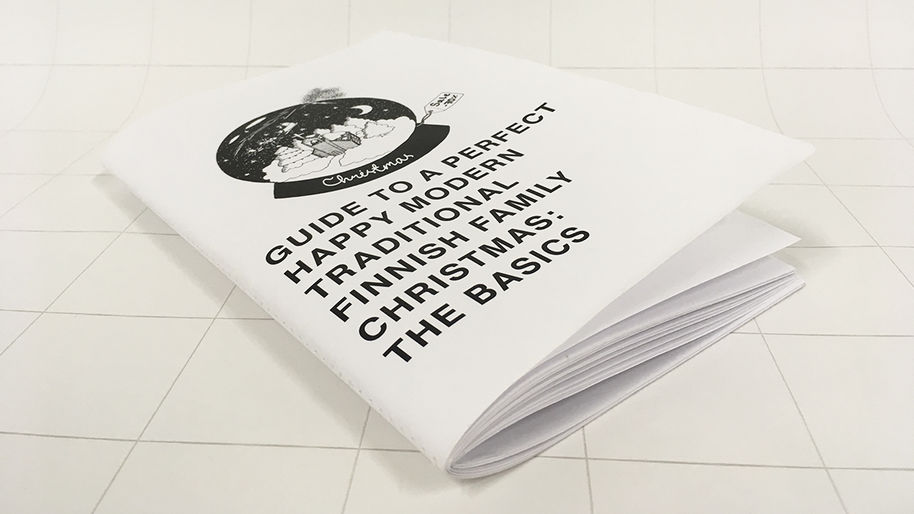
Prologue
Christmas, as we know it, is a rather family orientated holiday. This guide will demonstrate how to spend a traditional Finnish Christmas. Instructions are intended for stereotypical Finnish family, which includes one to two parents, and more than zero kids. Relatives of all sort are included, from pet dogs to second cousins. If you are not in such situation, we advise you to get into one.
By following the steps presented in this guide, you will know how to create a proper Christmas atmosphere. Detailed information about preparing the Ham, finding the Christmas tree, how to correctly act (around) Santa, and other essential Christmas elements are included. In this guide, we address the proper instructions for households, private persons, leaving out the public spaces and figures.
It is strongly recommended to follow and go through every step of each chapter, this is the only way to achieve a real and joyful Christmas.
Collaboration project by: Matteo Pennacchio, Santeri Valtanen, Hanna Kutvonen, Miska Viitala, You-Chia Chen
References:
- How Humans Became 'Consumers': A History, by Frank Trentmann, 2016
- Wood, J., (2007), “Designing for Micro‐utopias; thinking beyond the possible”
- Adam Curtis, 2005 “Century of the Self” (Liz Sandes, Pieter Jan Stappers, 1984: A Slice In Time)
- Pavlos Paraskevaidis, Konstantinos Andriotis (2014) Values of souvenirs as commodities
- Timo Rissanen, 13.9. Otaniemi
- Clark, H. (2012), “Conceptual Fashion”, in Adam Geczy and Vicki Karaminas (eds.): Fashion and Art. Oxford: Berg.
- Matteucci, G. (2017), ‘Fashion: A conceptual constellation’, in G. Matteucci and S. Marino (eds), Philosophical Perspectives on Fashion, London and New York: Bloomsbury, pp. 47–72.
- Reimers, V., Magnuson, B. and Chao, F. (2016), ‘The academic conceptualisation of ethical clothing’, Journal of Fashion Marketing and Management, 20:4, pp. 383–99.
- ”The role of stereotypes” Richard Dyer in Paul Marris and Sue Thornham: Media Studies: A Reader, 2nd Edition, Edinburgh University Press, 1999.
- The International Chindōgu Society
- Santa’s real workshop/
- Consumerism During the Holidays, and its Environmental Impact
- The Quirky Ways 7 Other Countries Celebrate Christmas
- Does Christmas music turn you into the Grinch?
- Naughty or nice, SantaCon revelers descend on New York
- Published:
- Updated:
